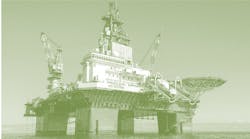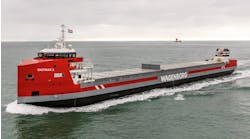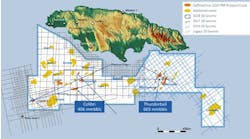David Paganie • Houston
BP outlines containment plans
At press time, BP had outline a detailed plan for building additional capacity and redundancy for the containment of oil from theDeepwater Horizon incident. This was in response to pressure from US authorities to step up containment efforts amid reports of increasing estimated rates of oil flow from the damaged well. In a letter to Coast Guard Read Admiral James A. Watson, BP outlined the following steps:
1. A 25,000 b/d oil capacity FPSO would be mobilized from South America as a backup to theToisa Pisces and Helix Producer I.
2. Two more lightering tankers were en route from Europe.
3. An added 3,800 ft (1,158 m) of 6-in. flexible hose was on its way from Brazil to backup subsea hoses.
4. Work continued to retrieve and repair the blue pod from theDeepwater Horizon BOP and to create added redundancy.
5. Work was under way to enable theDiscoverer Enterprise or Discoverer Clear Leader to connect to either permanent riser system.
6. Additional heat capacity was being organized for theDiscoverer Clear Leader test equipment to expand its installed capacity.
According to the letter, by mid to late July, BP planned to have a new LMRP cap with more seal integrity to ensure a relief well kill operations, and expanded recovery capacity for 60,000 to 80,000 b/d of oil. The recovery system would employ four vessels:Toisa Pisces and Helix Producer I would attach to the choke and kill lines with permanent risers; and Discoverer Enterprise and Discoverer Clear Leader would connect to the new cap with drill pipe and a suction pile, which is more hurricane efficient than using a riser, according to BP.
Deepwater moratorium
At the time of this writing, US District Court Judge Martin Feldman granted a preliminary injunction blocking the US Department of Interior’s moratorium on deepwater drilling. The US Court ruled in favor of Hornbeck Offshore Services vs. US Interior Secretary Ken Salazar, citing the US government failed to justify the six-month deepwater drilling moratorium.
On May 30, the MMS, in a Notice to Lessees and Operators (NTL), activated the moratorium on the drilling of new wells in 500 ft (152 m) of water or greater. The NTL also directed operators to cease drilling wells covered by the moratorium.
According to the NTL, activities not affected include:
OFFSHORE EUROPE
Jeremy Beckman • London
Norway, UK address drilling risks
Norway will move ahead with its 21st offshore licensing round, but will not sanction drilling on any deepwater permits until a clearer picture emerges over events leading up to theDeepwater Horizon incident in the US Gulf. “The precautionary principle combined with a predictable framework have to be the foundation for our petroleum politics,” said Petroleum and Energy Minister Terje Riis-Johansen.
Early last month, the UK’s new coalition government reacted by announcing that it would double mandatory rig inspections on the UK shelf from eight at present to 16 per year. In a separate development, industry body Oil & Gas UK set up an oil spill prevention and response advisory group (OSPRAG) to review general practice on the shelf, focussing on a range of issues including pan-North Sea regulations and response mechanisms.
Downward drift for Norwegian investment
With offshore Norway oil production (including NGLS and condensates) set to drop 4.5% this year to 2.2 MMb/d, the country needs to strike a balance in opening up its waters if it is to continue to attract fresh investment. Terje Riis-Johansen has acknowledged the importance of increased recovery from producing fields, and access to new acreage, to both the sector’s long-term development and the Norwegian economy. The government foresees total expenditure on the Norwegian shelf, including exploration costs, declining by 2.5% this year to $20.7 billion.
Exploratory drilling continues to focus on relatively low-risk targets. Among the latest successes, BP proved further reserves close to its current Skarv/Idun development in the Norwegian Sea. A well drilled by the semisubBorgland Dolphin on the Snadd North structure, 2 km (1.2 mi) west of Skarv, encountered gas in the Upper Cretaceous Lysing formation. Recoverable volumes look to be in the range 57-100 MMboe.
In the North Sea, Det norske oljeselskap found oil and gas in the Storlakken prospect, 20 km (12.4 mi) northwest of the decommissioned Froy field. Det norske remains committed to a re-development of Froy, in license PL 364, and aims to start issuing contracts this fall, assuming government approval for its soon-to-be-submitted plan.
BP launches subsea projects
Despite its troubles in the Gulf of Mexico, BP appears committed to production on the UK shelf. One of its imminent projects is the long-delayed $724-million Devenick gas/condensate development in 114 m (374 ft) water depth in blocks 9/24b and 9/29a in the northern UK North Sea.
At a recent briefing in London, German partner RWE Dea revealed that the field will be produced through one existing well and one new producer, linked via a four-slot subsea manifold and a 34-km (21-mi) pipeline to Marathon’s East Brae platform. According to Rene Pawel, RWE Dea UK managing director, the relatively high pressure and high temperature of the Upper Jurassic reservoir should not complicate the platform modifications program. Development drilling should start later this year, leading to first production in summer 2012.
BP is issuing contracts for its Andrew Area project in the central North Sea. Subsea 7 will engineer and install a 28-km (17.4-mi) bundle system, comprising pipelines for production, gas-lift, and methanol transport, to connect the Kinnoul and Arundel fields to the Andrew platform. Offshore installations should start next year.
Also in this area, Serica Energy is working on a multi-field development which would involve a new minimal facilities platform bridge-linked to BG’s Lomond platform, formerly operated by BP. The new installation would produce Serica’s Columbus gas discovery in blocks 23/16f; Dana’s Barbara and Phyllis gas fields; and potentially a Forties formation accumulation drilled by BG last year in adjacent block 23/21. FEED studies could lead to submission of an overall development plan later this year.
Access to UK infrastructure
Britain’s Department of Energy and Climate Change looks to widen access to North Sea production infrastructure in an attempt to galvanize development of third-party marginal or technically complex fields.
Deloitte’s energy, infrastructure, and utilities division welcomed the move – greater access was critical, said division head Carl Hughes, for Britain’s to maximize the value and recovery of its reserves. He also suggested a review of the current voluntary infrastructure code of practice, including compulsory arbitration, to promote greater use of new and aging offshore facilities.
“In addition, thought needs to be given to the extent to which the infrastructure owners are required to operate and maintain that infrastructure well beyond the lives of the fields to which it originally related. Incentives to encourage the sale and purchase of infrastructure … could facilitate this process.”
Scotland’s C02 options
A pan-industry project is under way to assess the suitability of carbon dioxide (CO2) storage in sandstones beneath the Moray Firth, 30 mi (48 km) from northeast Scotland. The program is funded by Shell, BG, and Schlumberger, among others, in partnership with Scotland’s government.
The Scottish Centre for Carbon Storage (SCCS) is assessing the technical and commercial viability of the Captain sandstone in this region as a CO2 store. According to SCCS, this is one of various sandstones filled with salt water that provide over 95% of potential CO2 storage capacity in the UK northern North Sea.
The program includes geological mapping and modeling to appraise the targeted rock’s thickness, extent and fluid flow properties. It will also address CO2 injection and monitoring issues. In time, SCCS says CO2 emitted from industrial sources could be transported to the region either via existing or newly installed subsea pipelines, potentially forming a CO2 pipeline network.
TheSeven Atlantic, Subsea 7’s new diving support vessel, has completed its first project for Shell in the UK southern gas basin. The program involved 80 saturation dives and 10 surface (air) dives. The dynamically positioned vessel is designed for at least 60 days at-sea endurance, and according to Subsea 7, can work faster than comparable DSVs. It has capacity for 24 divers using a twin bell system, and can accommodate up to 174 personnel.
Intervention or relief wells for emergency purposes, including the two relief wells by BP
- Operations that are necessary to sustain reservoir pressure from production wells
- Workover operations
- Waterflood, gas injection, or disposal wells
- Driling operations or other activities that are necessary to safely close or abandon a well, or to complete a well under CFR 250.500.
If the moratorium stands, it is too early to know how it will ultimately impact the industry, but with an estimated 33 deepwater rigs active at the time of the effective date, analysts predict that at least 50,000 jobs associated with those rigs could be at risk. At press time, a number of operators active in deepwater had declared force majeure on its drilling contracts, which likely would force those contracts to be canceled if the claims are deemed legitimate.
It also has been estimated that the drilling ban could represent a GDP loss of $12 billion, assuming the moratorium lasts for 12 months.
Exmar semi bound for GoM
LLOG Deepwater Development Co. LLC has agreed in principle to acquire the OPTI-EX semisubmersible production platform from EXMAR for use in the Gulf of Mexico. LLOG looks to install the facility in its Mississippi Canyon area development and initiate production in 2011. The platform will provide processing capacity of 60,000 b/d of oil and 150 MMcf/d of gas.




